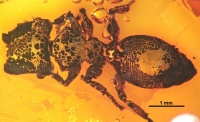Cephalotes squamosus
| †Cephalotes squamosus Temporal range: Burdigalian, Early Miocene Dominican amber, Dominican Republic | |
|---|---|

| |
| Scientific classification | |
| Kingdom: | Animalia |
| Phylum: | Arthropoda |
| Class: | Insecta |
| Order: | Hymenoptera |
| Family: | Formicidae |
| Subfamily: | Myrmicinae |
| Tribe: | Attini |
| Genus: | Cephalotes |
| Species: | †C. squamosus |
| Binomial name | |
| †Cephalotes squamosus (Vierbergen & Scheven, 1995) | |
| Synonyms | |
| |
One of a number of Cephalotes fossil species that are known from Dominican Amber.
Photo Gallery
Identification
A member of the multispinosus clade characterised, in the worker, by the vertex with a pair of denticles, as compared with its outgroup species, and by the long pronotal lamellae and absence of gastral spots as compared with the ingroup species. Some specimens of C. squamosus share with Cephalotes biguttatus and with the fossil Cephalotes hispaniolicus the propodeal lamellae beginning at some distance after the basal face, and share with biguttatus only a pair of vertexal denticles.
Keys including this Species
Distribution
This taxon was described from Dominican amber, Dominican Republic (Burdigalian, Early Miocene).
Castes
Nomenclature
The following information is derived from Barry Bolton's Online Catalogue of the Ants of the World.
- †squamosus. †Zacryptocerus squamosus Vierbergen & Scheven, 1995: 163, fig. 6 (w.) DOMINICAN AMBER (Dominican Republic, Miocene).
- Combination in Cephalotes: De Andrade & Baroni Urbani, 1999: 300.
- Status as species: De Andrade & Baroni Urbani, 1999: 300 (redescription).
- Senior synonym of †pseudoaztecus: De Andrade & Baroni Urbani, 1999: 300.
- †pseudoaztecus. †Zacryptocerus pseudoaztecus Vierbergen & Scheven, 1995: 163, fig. 7 (w.) DOMINICAN AMBER (Dominican Republic, Miocene).
- Junior synonym of †squamosus: De Andrade & Baroni Urbani, 1999: 300.
Type Material
Cephalotes squamosus
- Holotype: Staatliches Museum fur Naturkunde Stuttgart, no. Do-5696 (ex Coll. SCHEVEN), see de Andrade and Baroni Urbani (1999).
- Paratype: Museum of Comparative Zoology, one worker, MCZC-5, examined by de Andrade and Baroni Urbani (1999).
Cephalotes pseudoaztecus
- Holotype: Staatliches Museum fur Naturkunde Stuttgart, no. Do-5690 (ex Coll. SCHEVEN), see de Andrade and Baroni Urbani (1999).
- Paratype: Museum of Comparative Zoology, one worker, MCZC-3, examined, see de Andrade and Baroni Urbani (1999).
Unless otherwise noted the text for the remainder of this section is reported from the publication that includes the original description.
Description
Worker
de Andrade and Baroni Urbani (1999) - Head subquadrate. Frontal carinae superficially crenulate and gently upturned above the eyes. Vertexal angles round and with weakly crenulate margin. Vertexal margin concave medially. Vertex with a pair of denticles. Mandibles laterally angulate.
Mesosoma. Scapular angles absent. Anterior pronotal border straight, protruding anteriorly and passing into the sides with a long, weak concavity. Pronotal sides with a broad, long, continuos lamella with semitransparent border; anterior half of the lamella truncate in some specimens. Promesonotal suture often superficially impressed. Sides of the mesonotum unarmed or with a pair of round or truncate teeth. Propodeum with differentiate basal and declivous faces; sides of the basal face marked anteriorly and posteriorly by an angle; declivous face of the propodeum converging posteriorly; some specimens with a semitransparent lamella beginning at some distance after the basal face and narrowing backwards.
Petiole. Anterior face short and obliquely truncate, posterior face gently sloping anteriorly and concave medially. Petiolar sides with a pair of obtuse or round teeth medially. Postpetiolar node concave in the middle; anterior half of the postpetiolar sides with a pair of broad, round teeth.
Gaster suboval, with a pair of anterolateral, variably developed, lamellae.
Fore coxae angulate. Mid and hind femora angulate. Mid and hind basitarsi flat and with broad base.
Sculpture. Head minutely reticulate-punctate and with foveae about of the size of their interspaces, diminishing in size anteriorly, rare on the anterior fourth. Ventral face of the head with the same type of sculpture as the dorsum of the head and superimposed to irregular, anastomosing rugosities. Pronotum and mesonotum minutely reticulate-punctate and with foveae as broad as their interspaces; in some specimens the foveae are denser and superimposed by irregular, thin rugosities. Propodeum and pleurae reticulate and with longitudinal rugosities, the reticulation larger on the pleurae; propodeum also covered with superficial foveae variably clumped. Pedicel reticulate-punctate and with small, sparse to dense foveae. Gastral tergites, sides of the first gastral sternite, remaining sternites and legs strongly reticulate. First gastral tergite with longitudinal rugosities close to the postpetiolar insertion. Centre of the first gastral sternite shining.
Pilosity. Each fovea with a thin, appressed hair; similar hairs on the first tergite and sternite. Border of the vertexal angles, peduncular spines, legs and border of the gastral tergites and sternites with minute clubbed hairs. Posterior border of the first and second gastral sternites with rare, thin, erect, pointed hairs.
Colour. Frontal carinae, vertexal angles, pronotal lamellae, propodeal lamellae (when present) and anterolateral lamellae of the gaster ferrugineous and semitransparent. The majority of the specimens are often burned or covered by a gaseous layer preventing appreciation of the semi-transparency of the parts mentioned above.
Measurements (in mm) and indices: TL 3.96-6.52; HL 0.92-1.44; HW 1.16-1.92; EL 0.24-0.32; PW 1.00-1.68; PeW 0.43-0.56; PpW 0.46-0.68; HBaL 0.33-0.52; HBaW 0.14-0.24; CI 114.0-139.1; PI 105.1-120.7; PPeI 229.6-323.1; PPpI 210.2-262.5; HBaI 42.4-46.1.
References
- de Andrade, M. L.; Baroni Urbani, C. 1999. Diversity and adaptation in the ant genus Cephalotes, past and present. Stuttgarter Beitrage zur Naturkunde Series B (Geolgie and Palaontologie). 271:1-889. (page 300, Combination in Cephalotes and senior synonym of pseudoaztecus)
- Price, S.L., Blanchard, B.D., Powell, S., Blaimer, B.B., Moreau, C.S. 2022. Phylogenomics and fossil data inform the systematics and geographic range evolution of a diverse Neotropical ant lineage. Insect Systematics and Diversity 6(1): 9 (doi:10.1093/isd/ixab023).
- Vierbergen, G.; Scheven, J. 1995. Nine new species and a new genus of Dominican amber ants of the tribe (Cephalotini Hymenoptera: Formicidae) [sic]. Creat. Res. Soc. Q. 32: 158-170 (page 163, fig. 6 worker described)

